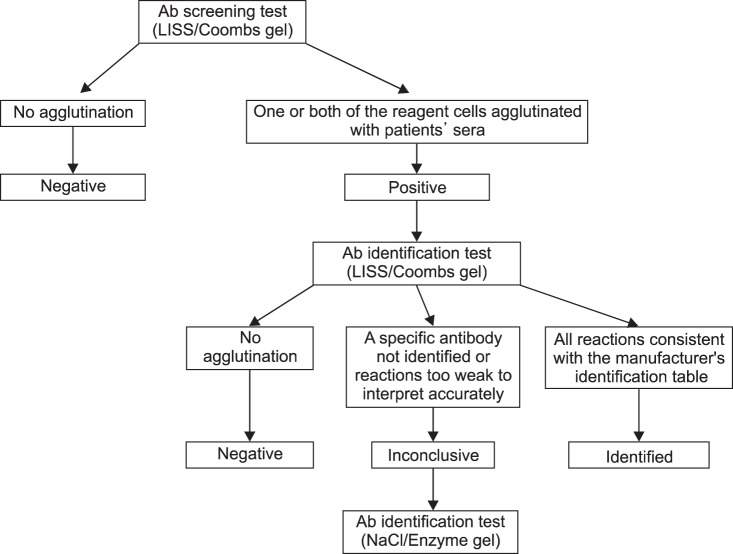Blood Res.
2013 Sep;48(3):217-221. 10.5045/br.2013.48.3.217.
Unexpected red cell antibody detection by conditional combination of LISS/Coombs and NaCl/Enzyme gel tests at a tertiary care hospital in Korea: A 5-year study
- Affiliations
-
- 1Department of Laboratory Medicine, Soonchunhyang University Hospital, Seoul, Korea. jwshin@schmc.ac.kr
- KMID: 2270709
- DOI: http://doi.org/10.5045/br.2013.48.3.217
Abstract
- BACKGROUND
A combination of the LISS/Coombs and enzyme methods is recommended for identifying unexpected antibodies. However, many laboratories in which tests are to be performed within the limits of medical fees covered by insurance, use only the LISS/Coombs method because the permissible medical fee is low as compared to the price of reagents required for both methods. The NaCl/Enzyme gel is used as a secondary assay when the LISS/Coombs gel test yields inconclusive results. We compared the frequency of unexpected antibody identified by LISS/Coombs gel with that obtained by the conditional combination of LISS/Coombs and NaCl/Enzyme gels. We aimed at establishing evidence-based guidelines for antibody testing.
METHODS
From June 2007 to June 2012, antibody screening was performed for 69,986 samples; subsequently, antibodies were identified in samples showing positive screening results. These initial screenings and identifications were performed using the LISS/Coombs gel. We considered the results "inconclusive" when specific antibodies were not identified or reactions were too weak for accurate interpretation. For the inconclusive samples, we subsequently used NaCl/Enzyme gels.
RESULTS
The overall detection rate of unexpected antibodies was 1.23%. Among the samples analyzed using NaCl/Enzyme gels, 40.2% showed results different from those obtained using LISS/Coombs gels. Moreover, 41.9% of samples with nonspecific reactions in LISS/Coombs gels showed clinically significant Rh or Kidd antibodies with NaCl/Enzyme gels.
CONCLUSION
Considering both patient safety and cost effectiveness, we recommend the use of conditional combination of LISS/Coombs and NaCl/Enzyme gels for antibody detection, especially in laboratories that must perform tests within an established budget.
MeSH Terms
Figure
Reference
-
1. Roback JD, Grossman BJ, Harris T, Hillyer CD, editors. Technical manual. 17th ed. Bethesda, MD: American Association of Blood Banks;2011. p. 463.2. Lee MH, Cho HI, Kim SI. A study on blood group antibodies in the Korean. Korean J Hematol. 1986; 21:243–256.3. Park MH, Kim SH, Song WH, Cho HI. Screening of irregular red cell antibodies by microplate method in transfusion candidates. Korean J Clin Pathol. 1986; 6:473–481.4. Han KS, Oh WI, Park MH, Kim EC, Kim SI. Irregular blood group antibodies in Korean. Korean J Hematol. 1989; 24:145–153.5. Cho HI. Studies on preparation of red cell panel and red cell antibodies in Koreans. Korean J Clin Pathol. 1982; 2:105–112.6. Kim BS, Kim HO, Song KS, Lee SY. Frequency of irregular antibodies detected by type and screen procedure. Korean J Blood Transfus. 1990; 1:47–49.7. Kim HO, Won DI, Kwon OH. The frequencies of unexpected antibodies in transfusion candidates and selection of cross-matching method. Korean J Blood Transfus. 1993; 4:35–41.8. Song DH, Moon IS, Hong SJ, Park JH, Kim JG, Jeon DS. Frequency and distribution of unexpected antibodies of Koreans. Korean J Blood Transfus. 1998; 9:191–200.9. Knight RC, de Silva M. New technologies for red-cell serology. Blood Rev. 1996; 10:101–110. PMID: 8813342.
Article10. Brecher ME, editor. Technical manual. 15th ed. Bethesda, MD: American Association of Blood Banks;2005. p. 284–285.11. Shin JH, Lee JY, Kim JH, Kim HR, Lee JN. Screening and identification of unexpected red cell antibodies by simultaneous LISS/Coombs and NaCl/Enzyme gel methods. J Korean Med Sci. 2009; 24:632–635. PMID: 19654944.
Article12. Chapman JF, Elliott C, Knowles SM, Milkins CE, Poole GD. Guidelines for compatibility procedures in blood transfusion laboratories. Transfus Med. 2004; 14:59–73. PMID: 15043595.
Article13. Roback JD, Grossman BJ, Harris T, Hillyer CD, editors. Technical manual. 17th ed. Bethesda, MD: American Association of Blood Banks;2011. p. 443.14. Issitt PD, Combs MR, Bredehoeft SJ, et al. Lack of clinical significance of "enzyme-only" red cell alloantibodies. Transfusion. 1993; 33:284–293. PMID: 8480348.
Article
- Full Text Links
- Actions
-
Cited
- CITED
-
- Close
- Share
- Similar articles
-
- Screening and Identification of Unexpected Red Cell Antibodies by Simultaneous LISS/Coombs and NaCl/Enzyme Gel Methods
- Usefulness of NaCl/Enzyme Gel Test for the Identification of Unexpected Antibodies
- Usefulness of Additional LISS/Coombs Card Test with Enzyme-Treated Red Cells in Detecting Anti-Kidd Antibodies Not Detectable by NaCl/Enzyme Card Test Alone
- Unexpected Antibody Positivity with the Use of the LISS/Coombs Gel Test
- An Evaluation of Gel Test for Irregular Antibody Screening


